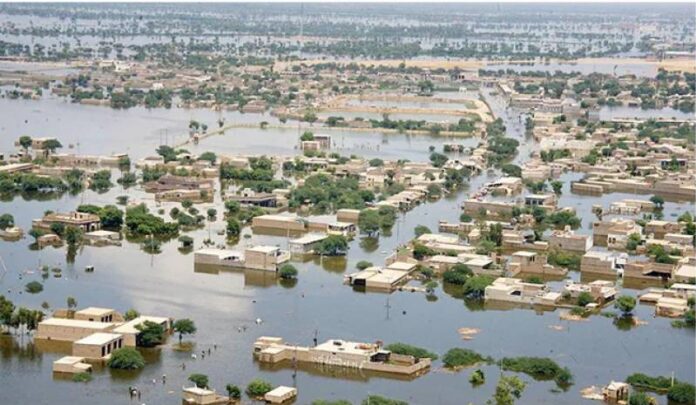Throughout this pathetic situation the country’s leaders are engrossed with endemic political discourses, while the constant torrential rains since early July have shattered a large part of the country primarily, Balochistan that has been hit the hardest by floods. The floods have swapped away the houses of urban areas largely, caused hundreds of casualties, and distracted the metropolitans more greatly by washing away most of the routes connecting the regions to other cities. Additionally, it has ravaged most of the agriculture sector, driving more people to starvation and to the downfall of the already stagnant economy. The role of climate havoc cannot be underestimated; nevertheless, the government is no less responsible for not having natural disaster management defense despite early warnings to tackle the crisis.
The flood drove the already underdeveloped province of Pakistan into a more unstable and perilous situation. Most of the areas of the province like Zhob, Khuzdar, Lasbela and Naseerabad Division were swept away by the flood. The flood has disconnected the affected region from the rest of the country. The main bridges and roads were shattered and the telecommunication system was broken down making it more remote. According to the PDMA, this strategic flood in Balochistan will further bring afflictions as more people will die due to the shortage of food, health, and shelter.
Heavy floods have also swept away Swat city which is called the Switzerland of Pakistan and high alerts were declared till August 30. The major hotels and restaurants were flushed away, and as a result, nearby communities are in danger. A flood is also expected in Quetta where there has been very heavy and constant rain. Additionally, Lasbela, the largest industrial city of Balochistan, is drowning in water. The flood has almost devastated the city’s means of livelihood, farms, and properties.
As per estimates up till now, the flood has affected 30 million people and wreaked havoc across Pakistan killing over 900 people. In Balochistan, 70 people were injured 13,535 houses collapsed or were partially damaged, and more than ten dams sustained minor or major damages during the rains. Similarly, 650 kilometers of roads, 13 bridges and 2431 solar plates were affected. Hundreds of thousands of people have been displaced.
According to the Provincial Disaster Management Authority (PDMA), 166 deaths were caused and 62 people were severely injured. The dead bodies of people including children beside and under the soil are a very gloomy and heart-wrenching moment. One of the flood victims says “ there is even no waterless place to bury the dead bodies”.
Apart from the loss of lives, there is much loss in the agricultural sector which was almost destroyed by the floods that left the urban residents much more vulnerable whose life is thoroughly pivoted on agribusiness. The flood weighed down the already plunging economy in the country. According to some reports, downpours have also washed out 712 livestock and 197,930 acres of standing crops cultivated in the affected areas. The actual figure must be much higher.
Helping the flood victims by providing relief and cash is not a permanent solution. The roads and bridges washed away by floods mostly in urban areas connecting the regions with cities must be constructed in a more technically refined way so that minor floods cannot easily swamp them away.
Besides that, there is a huge mismanagement. Because of the poor infrastructure structure, thousands of properties and houses were flooded and displaced by the floodwater. Houses, buildings, or restaurants are built in the flood ravines and near canals and rivers, which faced the destructive havoc. For example, several houses and hotels were flooded at Mingora by-pass. While the road of the Mingora by-pass was blocked for any kind of traveling as it was inundated with floodwater. The government had failed to construct great dams and rainfall canals in the provinces. Also, some of the poorly constructed water reservoirs in the provinces were washed away as of now.
The flood extensively vandalized the roads even more in mountainous areas. Many bridges collapsed, which connected the regions with other cities which rendered accessibility. The Provincial Disaster Management Authority (PDMA) said around 600 people in the cities of Quetta and Lasbela were stuck due to the highway closure. There is a great destruction in flooded cities which have to relocate the flood victims who are in amore pathetic condition. People cannot shift from one place to another as the water has surrounded the cities. Flood victims are stuck under open skies without water and food.
This scenario is a wake-up call for provincial and federal governments to encounter climate change. Due to climate change, regular monsoon rain turned into catastrophic floods. The poor developing countries are the victims of climate change and cannot encounter such a disastrous crisis. There is a dire need for a comprehensive and wide approach to climate change predicaments. The developed countries should take actions rather than having yearly conferences and dialogues. Both provincial and federal government must take the recent flood as an example to improve the flood warming mechanism and take the recent destruction as a sign to intensify initiatives to make better natural disaster management response
Besides that, natural barriers: forests, mangroves, coral reefs, and mountains are the protectors of natural cataclysms while human activities destroy them through deforestation and other ways needed for urbanization. Even though mangroves perform many beneficial functions including protection from storm surge, sea level rise, and coastal protection, they are not protected. In the Philippines, a country in Asia is known for its typhoons where mangroves have reduced annual flood damage by 25 percent. In Florida, roughly 469,000 acres of mangrove forests serve as the ultimate multitaskers.
However, the leaders are not less responsible for these ongoing predicaments. If they had shown concentration and had stood for serious measures earlier, it might be today we would not have had a huge loss. Like alerting people before the havoc, taking people out from risky places nearby valleys, and canals. But as usual, the most affected province, Balochistan, was drowning; on the other hand, the media and our leaders were busy with non-endemic political discourses.
Currently, it is now an extremely great challenge to recover from the losses from the floods in a large part of the country particularly in Sindh and Balochistan. Helping the flood victims by providing relief and cash is not a permanent solution. The roads and bridges washed away by floods mostly in urban areas connecting the regions with cities must be constructed in a more technically refined way so that minor floods cannot easily swamp them away. And the government must build more and more dams. Moreover, it must not authorize the construction of buildings in or beside canals to hinder the water flow which results in flood damage.
The flood put the already burdened people into a more chaotic situation. Like in 2010, the underprivileged sector of the country is most affected by the flood that caused a significant loss for them. The areas plotted were already lagging behind in the socioeconomic, educational, and economic sectors. The loss of infrastructure and livelihood throws them further behind. The floods harshly impacted the farmers washing away their crops, and other people most helpless in the country living below the poverty line.






















